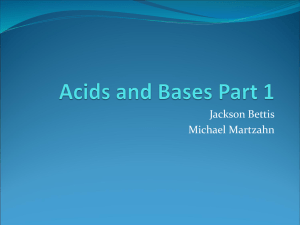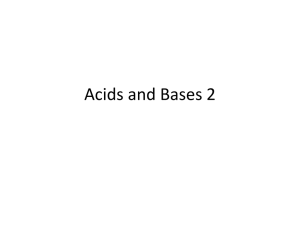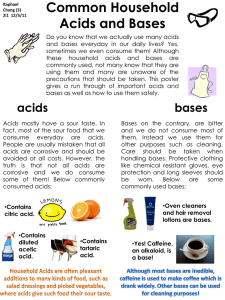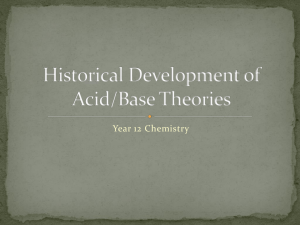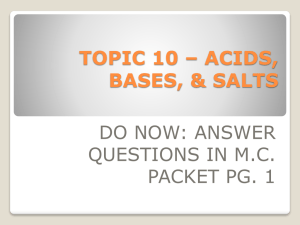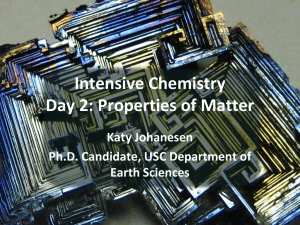Acids and Bases, Collision Theory
advertisement
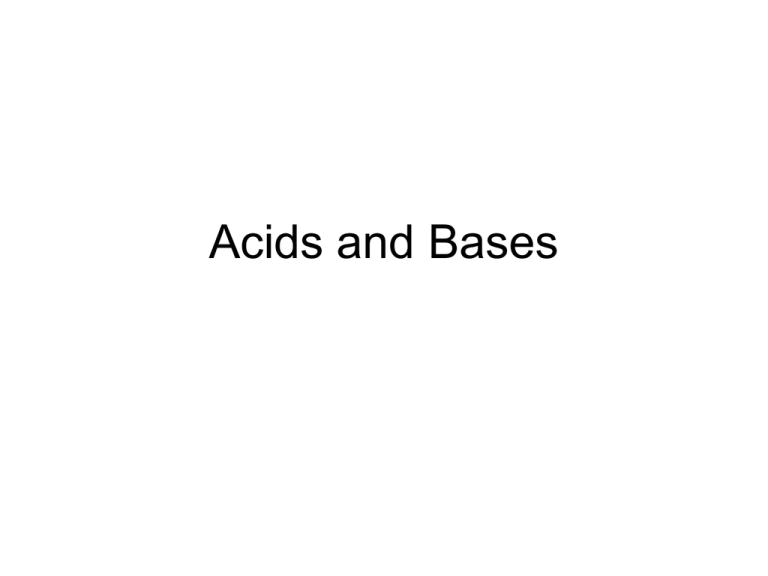
Acids and Bases Definitions Arrhenius Definitions • Acid – substance that produces hydrogen ions (H+) when dissolved in water • Base – substance that produces hydroxide ions (OH-) in water Properties ACIDS BASES Produce H+ in water Produce OH- in water Corrosive Corrosive Sour if dilute enough to drink/ingest Irritating when dilute Bitter if dilute enough to drink/ingest Slippery pH < 7 pH > 7 Properties • Acidic properties are due to the presence of H+ ions. – The more H+ the more acidic….the more corrosive, sour… • Basic properties are due to the presence of OH- ions – The more OH- ions the more basic the solution…..the more corrosive, bitter… Properties • Acids and bases neutralize each other. – the reaction of an acid with a base produces water and a salt (an ionic compound) • The resulting solution is neutral (pH =7) – no longer an acid or a base. HCl + NaOH NaCl + H2O Indicators • Acid-base indicators – color depends upon the acidity or alkalinity* of the solution – Litmus paper – Phenolphthalein * alkaline is another word for basic Indicators • Indicators in nature – Some hydrangea – Red cabbage juice Modern Definition of Acid and Base Bronsted – Lowry Definitions: • Acid – proton (H+) donor • Base – proton (H+) acceptor • Bronsted-Lowry definitions expand the number of substances that are classified as acid or base. Acids in Water • Bronsted and Lowry knew that each H+ released by an acid attaches to a water to form the hydronium ion, H3O+ HCl + H2O H3O+ + Cl- Label the acid and base in this reaction. Strong vs. Weak Acids • Acids can be classified as either strong or weak. – Strong acids release all of their H+ in water, weak acids release very few of their H+ Strong vs. Weak Acids • Strong acids – ionize 100% in water – Every acid molecule releases its H+ – There are only 4 strong acids, 3 listed: • HCl – hydrochloric acid • HNO3 – nitric acid • One H of H2SO4 – sulfuric acid Strong acids in water • HCl – already shown H 2O HNO3 + H2SO4 + H 2O Weak Acids • Weak acids – ionize slightly in water – Very few of the acid molecules release their H+, most stay in their molecular form (unionized) – Most acids are weak acids Weak Acids • Examples of weak acids – Acetic acid (vinegar), lactic acid, citric acid, ascorbic acid, acetylsalicylic acid…. • All acids except the strong acids presented are weak acids. • All carboxylic acids are weak acids – these are the type of acid most commonly found in living organisms Weak acids in water • The symbol written between reactants and products is different for weak acids. HCN + H2O New Terms • Conjugate acid – proton (H+) donor in the reverse reaction – The reverse reaction is the reaction that reforms the reactants. • Conjugate base - proton (H+) acceptor in the reverse reaction Weak acids in water • Write the reaction that shows the weak acid HC2H3O2 dissolving in water. • Label the acid, base, conjugate acid and conjugate base in this reaction. Strong and Weak Bases • Strong bases ionize fully in water. – Have OH- in their chemical formula – NaOH is a strong base • Weak bases ionize slightly in water. – Most nitrogen compounds are weak bases. – NH3 is a weak base Weak base in water NH3 + H 2O – Complete the reaction. – Label the acid, base, conjugate acid and conjugate base. New Term • Amphoteric – substance that can behave as an acid and a base – Water is amphoteric. pH Scale • The acidity or alkalinity of dilute acid or base solutions is commonly expressed as a pH. • Definition of pH: pH = -log [H+] [ ] means concentration pH Scale • Acids: pH <7 [H+] > [OH-] – The more H+ the more acidic the solution and the lower the pH. • Neutral: pH = 7 [H+] = [OH-] • Bases: pH > 7 [OH-] > [H+] – The more OH- the more basic the solution and higher the pH. pH Scale • The pH scale is based on the following finding. – In all aqueous solutions: [H+] x [OH-] = 1.0 x 10-14 pH Scale • In a neutral solution [H+] = [OH-] = 1 x 10-7 • pH = -log [H+] • pH = -log 1 x 10-7 = _____ pH Scale Consider an acidic solution with a pH of 2. • [H+] = ___________ • [OH-] = ___________ pH Scale Consider an acidic solution with a pH of 3. • [H+] = ___________ • [OH-] = ___________ pH Scale - Acids pH [H+] [OH-] 2 1 x 10-2 1 x 10-12 3 1 x 10-3 1 x 10-11 4 pH Scale -Bases pH 9 10 11 [H+] [OH-] pH Scale 1 2 3 4 5 6 7 8 9 10 11 12 13 14 Sample questions! • What is the pH of a solution that is 1000 x more acidic than pH 6? • What is the pH of a solution that is 10x less basic than pH 10? Buffered Solutions • Buffers – resist a change in pH even when acid or base is added • Made from weak acids or weak bases. – Strong acids/bases cannot be buffered – Most solutions in the body are buffered. Change of Topics! • Collision theory of a chemical reaction explains why reactions occur faster: – When the concentration of the reactant is increased – At higher temperatures – In the presence of catalysts Collision Theory • Collision theory of a chemical reaction: – for a reaction to occur the reactants must collide in proper orientation and with sufficient force to meet the activation energy (Ea). – Any collision not meeting both of these criteria does not result in a chemical reaction. • The rest of the lecture will be presented on the board.

